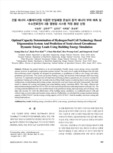

-
 * 본 문서는 배포용으로 복사 및 편집이 불가합니다.
* 본 문서는 배포용으로 복사 및 편집이 불가합니다.
미리보기
서지정보
· 발행기관 : 한국생물환경조절학회
· 수록지 정보 : 생물환경조절학회지(구 시설원예ㆍ식물공장) / 32권 / 3호
· 저자명 : 이승헌, 김락우, 김찬민, 석희웅, 윤성욱
목차
서 론
재료 및 방법
1. 대상 시설 및 지역
2. 건물 에너지 시뮬레이션
3. 작물 및 토양에너지 교환 모델
4. 수소연료전지 3중 열병합 시스템
5. 냉·난방 부하 분석 방법
결과 및 고찰
1. 기상 데이터 분석
2. BES 모델 설계
3. 작물 에너지 교환 고려 여부에 따른 냉·난방 부하 분석
4. 정적 에너지 분석과 동적 에너지 분석 비교
5. 수소연료전지 3중 열병합 시스템 적정 용량 산정
결 론
적 요
사 사초록
수소는 다양한 신재생에너지 중 환경친화적인 에너지로 각광받고 있지만 농업에 적용된 사례는 드물다. 본 연구는 수소 연료전지 삼중 열병합 시스템을 온실에 적용하여 에너지를 절 약하고 온실가스를 줄이고자 한다. 이 시스템은 배출된 열을 회수하면서 수소로부터 난방, 냉각 및 전기를 생산할 수 있다. 수소 연료 전지 삼중 열 병합 시스템을 온실에 적용하기 위해 서는 온실의 냉난방 부하 분석이 필요하다. 이를 위해서는 온 실의 형태, 냉난방 시스템, 작물 등을 고려해야 한다. 따라서 본 연구에서는 건물 에너지 시뮬레이션(BES)을 활용하여 냉 난방 부하를 추정하고자 한다. 전주지역의 토마토를 재배하 는 반밀폐형 온실을 대상으로 2012년부터 2021년까지의 기 상데이터를 수집하여 분석했다. 온실 설계도를 참고하여 피 복재와 골조를 모델화하여 작물 에너지와 토양 에너지 교환을 실시했다. 건물 에너지 시뮬레이션의 유효성을 검증하기 위 해 작물의 유무에 의한 분석, 정적 에너지 및 동적 에너지 분석 을 실시했다. 또한 월별 최대 냉난방 부하 분석에 의해 평균 최 대 난방 용량 449,578kJ·h-1, 냉방 용량 431,187kJ·h-1이 산정 되었다.영어초록
Hydrogen has gained attention as an environmentally friendly energy source among various renewable options, however, its application in agriculture remains limited. This study aims to apply the hydrogen fuel cell triple heat-combining system, originally not designed for greenhouses, to greenhouses in order to save energy and reduce greenhouse gas emissions. This system can produce heating, cooling, and electricity from hydrogen while recovering waste heat. To implement a hydrogen fuel cell triple heat-combining system in a greenhouse, it is crucial to evaluate the greenhouse's heating and cooling load. Accurate analysis of these loads requires considering factors such as greenhouse configuration, existing heating and cooling systems, and specific crop types being cultivated. Consequently, this study aimed to estimate the cooling and heating load using building energy simulation (BES). This study collected and analyzed meteorological data from 2012 to 2021 for semi-enclosed greenhouses cultivating tomatoes in Jeonju City. The covering material and framework were modeled based on the greenhouse design, and crop energy and soil energy were taken into account. To verify the effectiveness of the building energy simulation, we conducted analyses with and without crops, as well as static and dynamic energy analyses. Furthermore, we calculated the average maximum heating capacity of 449,578 kJ·h-1 and the average cooling capacity of 431,187 kJ·h-1 from the monthly maximum cooling and heating load analyses.참고자료
· 없음태그
-
자료후기
-
자주묻는질문의 답변을 확인해 주세요

꼭 알아주세요
-
본 학술논문은 (주)코리아스칼라와 각 학회간에 저작권계약이 체결된 것으로 AgentSoft가 제공 하고 있습니다.
본 저작물을 불법적으로 이용시는 법적인 제재가 가해질 수 있습니다. -
해피캠퍼스는 구매자와 판매자 모두가 만족하는 서비스가 되도록 노력하고 있으며, 아래의 4가지 자료환불 조건을 꼭 확인해주시기 바랍니다.
파일오류 중복자료 저작권 없음 설명과 실제 내용 불일치 파일의 다운로드가 제대로 되지 않거나 파일형식에 맞는 프로그램으로 정상 작동하지 않는 경우 다른 자료와 70% 이상 내용이 일치하는 경우 (중복임을 확인할 수 있는 근거 필요함) 인터넷의 다른 사이트, 연구기관, 학교, 서적 등의 자료를 도용한 경우 자료의 설명과 실제 자료의 내용이 일치하지 않는 경우
“생물환경조절학회지(구 시설원예ㆍ식물공장)”의 다른 논문도 확인해 보세요!
-
양액의 NO3 - 비율이 수경재배 참외의 생육과 수량에 미치는 영향 7 페이지
참외는 동북아시아 지역에서 대부분 재배되고 있고, 한국에 서 주로 생산되는 과일로서 단위면적당 수확량은 지속적으로 향상되고 있지만 재배방식은 토경재배에 국한되어 있기 때문 에 규모화, 생력화를 위한 수경재배 기술 개발이 필요하다. 본 연구에서는 보온부직포를 이용한 수경재배로 참외를 재배할 때 영양생장기 배양액 내 질산태질소 비율에 따른 참외 생육 의 변화를.. -
생장조정제 처리 후 생육 시기별 퍼레니얼 라이그래스의 억제 효과 7 페이지
본 연구는 퍼레니얼 라이그래스에서 생장조정제 trienexapacethyl과 prohexadione-calcium을 처리하였을 때 생육 시기별 잔디 품질과 생육 억제 효과를 조사하였다. 처리구는 대조구 (Control), TE 처리구(0.01 a.i. g·m-2·100mL-1) 및 PC 처리구 (0.01 a.i. g·m-2·100mL-1)으로 설정하였다. .. -
밀폐형 식물생산시스템에서 마이크로버블 처리에 따른 상추와 배초향의 생장 특성 8 페이지
본 연구는 DFT 재배 시스템을 이용한 밀폐형 식물생산시스 템에 MB처리 유무에 따른 상추(Lactuca sativa L.)와 배초향 (Agastache rugosa Kuntze)의 생육과 양액 특성을 조사하기 위해 수행되었다. 상추와 배초향은 밀폐형 식물생산시스템에 서 23일간 재배되었다. MB는 매일 9시, 13시, 17시에 5분씩 16일간 처리하였다... -
하절기 오이 온실재배 시 차광 및 보광 효과 8 페이지
하절기의 높은 일사량은 작물의 과도한 호흡을 유발하여 광 합성을 감소시킨다. 또한 주로 하절기에 발생하는 장마는 온실 내부에 저일조 환경을 유발한다. 저일조 환경은 작물의 생 육과 생산량을 감소시키는 원인이 될 수 있다. 본 연구는 하절 기 차광과 보광이 오이의 생육과 생산량에 미치는 영향에 대 해서 조사하기 위해 수행되었다. 오이 접목묘는 2022년 8월.. -
유묘단계에서 단시간 마이크로웨이브 처리가 상추의 생육 및 이차대사산물 함량에 미치는 영향 9 페이지
본 실험은 마이크로웨이브 처리가 상추 유묘의 생육 변화와 이차대사산물 함량의 변화를 알아보고자 수행되었다. 파종 후 3주째 상추 유묘에 2.45GHz 주파수와 200W의 마이크로 웨이브를 0, 4, 8 및 12초 동안 처리하고, 4주간 식물공장에서 재배한 후 생육 및 성분 분석을 수행하였다. 지하부와 지상부 의 생체중과 건물중, 엽면적, 엽장 및 엽수는 마..
문서 초안을 생성해주는 EasyAI


